
The Abraham Browne House is a colonial house located at 562 Main Street, Watertown, Massachusetts, US. It is now a nonprofit museum operated by Historic New England and open to the public two afternoons per year.

The Campbell-Christie House is a historic home that has been relocated to New Bridge Landing in River Edge, Bergen County, New Jersey. It was added to the National Register of Historic Places on January 10, 1983, as part of the Early Stone Houses of Bergen County Multiple Property Submission (MPS).
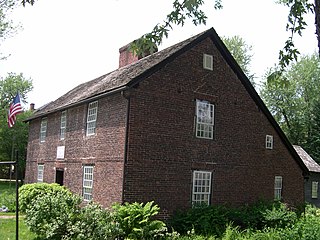
The Josiah Day House is a historic house museum at 70 Park Street in West Springfield, Massachusetts, United States. Built about 1754, it is believed to be the oldest known brick saltbox style house in the United States. It was listed on the National Register of Historic Places in 1975. It is owned by the local historical society, and is occasionally open for guided tours.
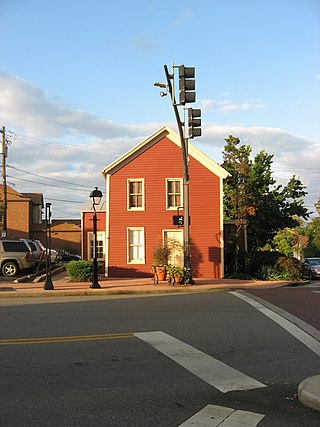
The Yost Tavern is a historic former inn in the city of Montgomery, Ohio, United States. Built in 1805, when Montgomery was founded, it remained in operation as a lodging establishment until a long period of use as a house, and it was donated to the city after being owned by the local Kiwanis chapter. It has also been named a historic site.

The John Ward House is a National Historic Landmark at 9 Brown Street in Salem, Massachusetts, United States. With an early construction history between 1684 and 1723, it is an excellent example of First Period architecture, and as the subject of an early 20th-century restoration by antiquarian George Francis Dow, it is an important example of the restoration techniques. Now owned by the Peabody Essex Museum, it is also one of the first colonial-era houses in the United States to be opened as a museum. It was designated a National Historic Landmark in 1968.
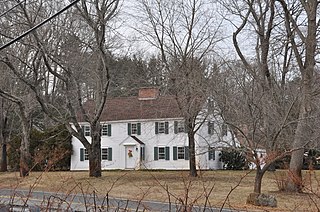
The Abbot-Baker House is a historic house at 5 Argilla Road in Andover, Massachusetts. Estimated to have been built about 1685, it is one of Andover's oldest houses, supposedly built by a third-generation colonist. It was listed on the National Register of Historic Places in 1982.
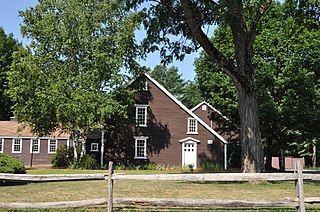
The Manning Manse is a historic house at 56 Chelmsford Road in North Billerica, Massachusetts. Built about 1696, it is one of the oldest surviving buildings in Billerica. It has further associations with local and nationally prominent members of the Manning family, and is a significant early example of historic preservation in the United States. Since the mid-20th century it has typically housed a restaurant, under lease from a family association. It was listed on the National Register of Historic Places in 1982.

The Capt. Nathaniel Parker Red House is a historic house at 77–83 Ash Street in Reading, Massachusetts. It is a 2+1⁄2-story vernacular Georgian house, five bays wide, with entrances on its north and south facades. The southern entry is slightly more elegant, with flanking pilasters and a transom window. The house was built sometime before 1755, and was already a well-known landmark because it was painted, and served as a tavern on the coach road. The Tavern served as a meeting place for many revolutionaries and minute men, notably Marquis de Lafayette, and Alexander Hamilton. The house remained in the hands of militia captain Nathaniel Parker and his descendants into the late 19th century. The construction of the Andover Turnpike in 1806–07, bypassing its location, prompted a decline in the tavern's business.

The Carroll–Hartshorn House is a historic First Period house at 572 Haverhill Street in Reading, Massachusetts. Built c. 1700, it is one of the oldest buildings in Reading, set on an early route between Wakefield and Haverhill. It has a classic two-story, five-bay, central-chimney plan, with a rear shed extension giving the house a saltbox appearance. Its windows, some still with original surrounds, are narrower and taller than typical for the period. The property was owned by generations of the Hartshorn family.

The Daniel Nichols Homestead is a historic home in Reading, Massachusetts. The oldest portion of this timber-frame house was built in the early 1740, with vernacular Georgian styling. The house is five bays wide and two deep, with a rear shed-roof extension giving the house a saltbox appearance. An ell was added in the mid-19th century. The main architectural detail is the front door surround, which features sidelight windows and recessed, paneled pilasters supporting a tall entablature.

The Ephraim Weston House is a historic house in Reading, Massachusetts. It is incorrectly listed on the National Register of Historic Places as the Ephrain Weston House, at 224 West Street. It was built in the early years of the 19th century by Ephraim Weston, a local real estate developer and businessman; he operated a local general store and a shoe manufacturing business, one of the early such businesses in the town. It is a two-story wood-frame structure, with a hip roof and two chimneys. The main facade faces south, and has a single-story porch extending across its width, supported by square posts. The building corners are pilastered, and a single-story bay projects from the west side. The house is locally distinctive as a rare Federal period house with a hip roof and later applied Italianate styling.

The James Nichols House is a historic house in Reading, Massachusetts. Built c. 1795, this 1+1⁄2-story gambrel-roofed house is built in a vernacular Georgian style, and is a rare local example of the style. The house was built by a local shoemaker and farmer who was involved in a religious dispute that divided the town. The house was listed on the National Register of Historic Places in 1984.

The Samuel Bancroft House is a historic house in Reading, Massachusetts. With an estimated construction date of 1748, it is one of the town's older surviving houses, and one of a small number from the late colonial period. It was listed on the National Register of Historic Places in 1984.

The Thaddeus Jackson House is a historic house at 15 Alberta Road in Brookline, Massachusetts. Built in 1820, it is one of Brookline's older surviving houses, unusual because it was built in the Georgian style, then already out of fashion. The house was listed on the National Register of Historic Places on October 17, 1985.

The Griswold House is a historic house museum at 171 Boston Street in Guilford, Connecticut. Built about 1764, it is a well-preserved example of New England colonial architecture, and was listed on the National Register of Historic Places in 1975. The Guilford Keeping Society operates the house as the Thomas Griswold House Museum. The museum includes the late 18th century period New England saltbox house, a historic blacksmith shop, a barn with farm tools and implements, two corn cribs and a Victorian era three seat outhouse. The museum is open seasonally from June through October on a limited number of days each week.
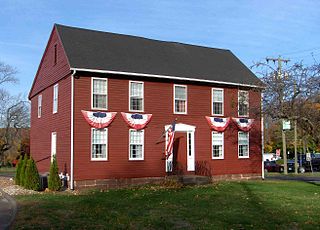
The Jonathan Root House is a historic house at 140–142 North Main Street in Southington, Connecticut. Built about 1720, it is believed to be the oldest surviving colonial building in the town. It was listed on the National Register of Historic Places in 1989, and now houses professional offices.

The Bullard House is an historic house at 4 Woodward Avenue in the center of Berlin, Massachusetts. The 2+1⁄2-story wood-frame house has a complex construction history, having been modified or extended numerous times since its oldest portion was built c. 1780. This old portion was probably three bays wide and two stories high, with an entrance near the east present facade corner. In the early 1790s the building's size was greatly expanded, with additions to the west and rear, giving it a saltbox appearance. In the 1850s the west side of the rear leanto was further extended to add a new kitchen space. A shed was added to this kitchen space in the 1920s and enlarged in 1956, and a shed dormer was added to the east rear of the building.
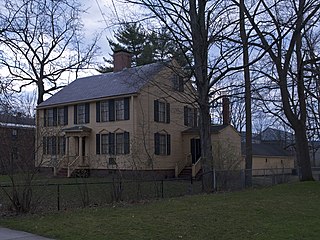
The Wyman Tavern is a historic house, former tavern, and now a local history museum, at 339 Main Street in Keene, New Hampshire. Built in 1762 by Isaac Wyman, it also served as the muster ground for militia at the outbreak of the American Revolutionary War. In 1968 the property was acquired by a local non-profit, which leases it to the Cheshire County Historical Society for use as a museum. The building was listed on the National Register of Historic Places in 1972.

The Fobes-O'Donnell House is a historic house museum at 1221 Old Turnpike Road in Oakham, Massachusetts. Probably built in the second half of the 18th century, it served as a tavern on what was then a major through road, and housed the town's first post office. It is now operated as a museum by the local historical society. The house was listed on the National Register of Historic Places in 2018.






















